California
Number of Victims
In total, 20,108 people were
sterilized in the state of California prior to 1964. California had by far the
highest number of sterilizations in the United States (one third of all
sterilizations nationwide). The numbers of men and women sterilized were about
equal. Of the total sterilizations, almost 60% were considered mentally ill and
more than 35% were considered mentally deficient. Men and women of Mexican
origin represented between 7% and 8% of those sterilized (Stern, Eugenic
Nation, p. 111). African Americans made up 1% of California’s population
but accounted for 4% of the sterilizations (Stern, Eugenic Nation,
p.
111). However, because of the sensitive nature of sterilization
records,
many are difficult to access or have been altered. This suggests that
the total
known number of sterilizations may be conservative compared to the
actual number (Stern, "From Legislation to Lived Experience," p. 97).
Period during which sterilizations occurred
The
first sterilization law was passed in 1909. From here, sterilizations occurred
at a steady increasing rate until about 1950. Prior to 1921, there were
2,558 sterilizations and this rate continued to increase until around 1950.
California differed from many other states, in that, sterilizations did not
significantly decrease with the Great Depression (Clayton, p. 43). After 1950,
the rate slowed, and only 85 sterilizations occurred after 1960.
Temporal Pattern of sterilizations and rate of sterilization
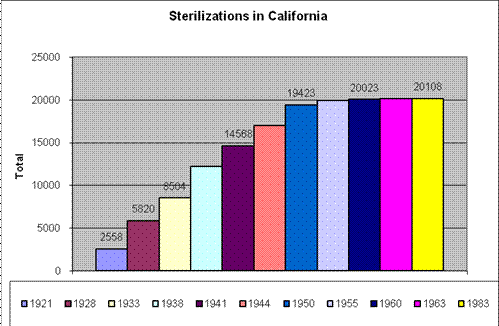
Passage of Laws
Eugenicist
in California saw sterilization as a tool with a broad range of applications,
all of which were applied to prevent the procreation of undesirable traits, overcrowding
of state institutions, and to alleviate fiscal constraints on the state
(Bruinius, p. 211).
The first state sterilization law in California was enacted on April 26, 1909
and remained largely unopposed for the next 70 years (Laughlin, p. 1).
This was the first of three laws passed in California and it targeted patients
in state hospitals and institutions for the mentally retarded, as well as
prison inmates. Of the prison inmates, those labeled sex offenders were
the most commonly targeted. At the time of the passage of this law, the
approval of the superintendent of the institutions, the superintendent of the
state hospitals and the secretary of the State Board of Health were consulted.
If two out of three of them approved, the sterilization could be carried out
(Paul, pp. 256-257).
A second law was passed on June 13, 1913. This law repealed the first law
and established different guidelines (Gottshall and Laughlin, p. 2). It allowed
for a wider range of people to be sterilized. Anyone who was “afflicted
with hereditary insanity or incurable chronic mania or dementia” (Braslow, pp.
33-34) could be sterilized. This law also established the State Lunacy
Commission, which had the power to order sterilizations. However, this law did
call for parental consent in the case of the sterilization of minors (Braslow,
p. 34).
The third law, enacted at the end of July, 1917, created modifications to the
1913 sterilization law by expanding the scope of who could be sterilized
(Kline, p. 50). Two amendments were made to the 1913 law which included
specific references to the Sonoma State Home and the Pacific Colony (Laughlin,
pp. 3, 7, 8). The law established the Pacific Colony and allowed the Board of
Trustees of this institution to grant permission for sterilizations of those
living there (Gottshall).
The sterilization laws were significant largely for their overt language,
effectively applying to anyone who we deemed abnormal, as well as for the omission
in terms of patient rights (Stern, "From Legislation to Lived
Experience," p. 101). There was no
legal mechanism for patients to challenge the sterilization order, no written
notification required to be sent to the patient of family, and no opportunity
for a hearing that the institutional level (Stern, "From Legislation to Lived
Experience," p.
101).
In both 1935 and 1937, legislation was drafted that would have established a
State Eugenics Board and further expanded the state's authority to perform
sterilizations to include inmates and residents of behavioral and other
non-mental reformatory institutions. However, the bills failed and never
became law (Stern, Eugenic Nation, p. 83).
The California sterilization law saw further changes in the 1930’s (Currell and
Cogdell, p. 34). Ann Cooper Hewitt, a rich heiress, attempted to sue her
mother, Dr. Tilton E Tillman and Samuel G. Boyd for sterilization without
consent. Ann’s mother had requested sterilization for her daughter
because of sexual misconduct (Currell and Cogdell, p. 35). The case
brought up an unexplored the constitutionality of sterilization in a private
practice (rather than public institution) without consent. While the
current law did not specify if those doctors that performed sterilizations at
private practices were protected, Judge Tuttle dismissed the case, saying that
sterilization performed at private practices without consent of the patient
were perfectly legal as long as a guardian had requested the operation (Currell
and Cogdell, p. 36). This was a significant specification. The scope
of sterilization was widened to include those who were not in institutions, but
whose parents or guardians deemed sterilization necessary for their unruly
children (Currell and Cogdell, p. 36). Further, this case exemplified
the growing shift from using heredity as the main reasoning for
sterilization. Now, questionable sexual behavior was enough. Those
who were diagnosed with this “disorder” were predicted to be unfit for
parenthood (Currell and Cogdell, p. 35). Further, for some,
sterilization became a private family matter where the guardian could simply
sign a few papers in order to get his/her child sterilized-alleviating the
burden on eugenicists and expanding sterilization to the middle and upper
classes of society (Currell and Cogdell, p. 36). Butler saw this decision
could have a large impact of nationwide sterilization rates and as a step
toward preventing race degeneration. Consequently, he sent hundreds of
copies of the decisions to private physicians all over the country (Currell and
Cogdell, p. 37).
In part as a result of the Garcia v. State Department trial, in 1951, the
laws were amended to require full authorization from the patient in order to
perform sterilizations (Stern, "From Legislation to Lived
Experience", p. 102). This effectively made the process of
sterilization much more burdensome for the physician-causing a decrease in
sterilization rates. In 1950, Sonoma sterilized 5, 550 patients, two years
later, they would sterilize just 4. These transitions along with statements
made by the Department of Mental Hygiene, and others, throughout the 1950s
further affirmed the psychiatric movement away from sterilization (Paul, p.
267). These laws, combined, allowed eugenic sterilizations to occur in the
state of California through 1964 (Gottshall).
In 1927, in an 8-to-1 decision, the United States Supreme Court upheld the
constitutionality of Virginia's—and, by extension, California's—mandatory
sterilization law in the case of Buck v. Bell. However, in 2003, the California
Senate issued Senate Resolution No. 20 to apologize for California's eugenics
laws (see Center for Science, History, Policy, and Ethics).
Groups identified in the Law
The
1909 law was aimed specifically at those in prisons and with mental
disabilities that caused them to be institutionalized. Of those with
mental disabilities, the law targeted patients in state hospitals and
institutions of the feeble-minded. In terms of the prisoners, the law
targeted those who were inmates for life, showing “sex or moral perversions”,
or were certain repeat offenders (Gottshall and Laughlin, p. 7). The 1913 law
expanded to target all inmates in state hospitals or homes for the
feeble-minded (except voluntary patients in state hospitals), as well as all
repeat offenders in state prisons (Laughlin, p.7). The 1917 amendments greatly
expanded the groups targeted even further to include those who had hereditary
mental diseases, “those suffering from perversion or marked departures from
normal mentality”, and those with sexually-transmitted diseases (Laughlin,
pp. 7-8). These two later laws expanded to include virtually any individual
deemed unfit. About 70% of all sterilization were performed on people who were labeled mentally ill
(see Paul, p. 261).
Process of the Law
In
1909, in order to legally sterilize someone, the approval of any two of the
three following individuals was required: the superintendent or resident
physician of the institution, the superintendent of state hospitals, and the
secretary of the State Board of Health (Gottshall). If these approvals
were given, sterilization could occur (Gottshall). In 1913, the jurisdiction
over sterilization in California expanded to include the “State Lunacy
Commission” and gave it the authority to order the sterilization of an
individual with certain mental illnesses. In 1917, after the
establishment of the institution called the Pacific Colony, which dealt with
the sterilization of epileptics and mentally delayed individuals, authorization
procedures for sterilization changed. Sterilizations required the authorization by a Board of
Trustees, and a clinical psychologist with a Ph.D. (Gottshall). For all,
although consent from the sterilized individual or their family was not
required, it was usually received (Butler). However, many individuals may have
given consent so that they would be allowed to leave the hospital (Braslow, p.
43). Neither records nor reports were required by any of the California
sterilization laws to be kept (Laughlin, p. 137).
Precipitating Factors and Processes
Around the turn of the
century, increased immigration led to changes in California’s demographics
(Stern, Eugenic Nation, pp. 57-59). Between the years 1890-1910, 12
million people immigrated into the United States (Bruinius, p. 256). To curb this
influx, legislation such as Theodore Roosevelt’s Gentleman’s Agreement, and the
Chinese Exclusion Acts, were enacted (Bruinius, p. 256). Especially
important was the influx of Mexicans looking for work. Their presence cost the
state a lot of money in charity and welfare. Further, Mexicans were stereotyped
to be diseased. Eugenicists such as Charles M. Goethe warned their presence
in the United States would cause the spread of diseases such as Tuberculosis
(Kline, p. 67). This began a process of trying to keep undesirable Mexicans out of the United States (Stern, Eugenic Nation,
pp. 57-59). Between the years 1926-1928, 40% of those deported in the United
States were Mexicans (mostly from Southern California) (Stern, Eugenic
Nation, p. 213). As a result, progressives began to look for a
way to easily eliminate degeneracy and disorder in the new chaos (Gottshall).
European settlers sought to establish a community, based on modern science,
which fulfilled the Manifest Destiny and downplayed the Spanish and Mexican
past of the territory (Stern, Eugenic Nation, p. 85). Furthermore,
African-American men were seen as being excessively virile and this needed to
be controlled to protect women (Kline, p. 9). Similarly, the idea of “race
suicide” emerged on a national level. This concept stated that women of
good stock should be having children in order to ensure that the white middle class
not be taken over by inferiors (Kline, p. 11).
The changing economy led to changing gender roles in society. As the economy
became more corporate, white men were becoming perceived as less masculine due
to the desk jobs they often occupied (Kline, p. 9). At the same time more and
more women began to work outside of the home. These women were seen as overly
sexual and challenging to the traditional roles of middle class women (Kline,
pp. 10-11). Many doctors were concerned with women giving birth out of wedlock.
This caused doctors to sterilize some women in order to prevent this from
happening (Braslow, p. 47). Progressive Era reformers saw these changes and
began to implement eugenic programs to help “better” society (Stern,
“Sterilized,” p. 1123).
The driving force behind the statutes regarding sterilization in California was
mainly eugenic in nature, although they were also allegedly designed to benefit inmates in a
physical, mental, moral, or therapeutic manner. There was a somewhat punitive
motivation behind them as well (see Laughlin, p.7). After World War I, and the
change in the perception of "feeble-mindedness" from a crime to a disease, there was a noted
shift across the country from “institutions” to “hospitals” and “inmates” to
“patients” (Kline, p. 45). In the waning years of sterilization in California,
the rationale shifted from eugenics to “fears of overpopulation, welfare
dependency, and illegitimacy” (Stern, “Sterilized,” p. 1132).
Groups Targeted and Victimized
Those individuals targeted generally fell into one of three categories, dependent, delinquent, or mental deficient (Bruinius, p. 10). They were thought to threaten the strength and wellbeing of the race (Kline, p. 37).
Those who were “dependent” generally lacked formal education and received
welfare payments from the government. Motivated to prevent the
procreation of the poor, eugenicists attempted to eradicate this undesirable trait
from the general population (Kline, p. 38). Further, because
of their lack of education, these individuals were vulnerable and easy to
victimize. This resulted in many sterilizations of refugees from the Dust Bowl
in the later 1920s and early 1930s (Clayton, p. 44).
The definition of “delinquency” varied with men and women (Kline, pp. 37-40).
Women who were seen as sexually promiscuous were often sterilized as a
“cure” for their actions. (This was
because sexual promiscuity was seen as a symptom of feeblemindedness (Kline, p.
36). Further, it attacked the termed “high grade moron” that Goddard
threatened could have the greatest negative effect on a race because, although
they seemed mentally normal and would go undetected on intelligence tests,
their sexual deviance could cause the procreation of more sexually deviant
women (Kline, p. 37). Men differed in that sterilization was seen as a
rehabilitative treatment to prevent destructive traits such as petty crime
(Stern, Eugenic Nation, p. 96).
Mental deficiency was a very broad term, including everything from
the socially undesirable traits such as sexual promiscuity, to schizophrenia.
These included alcoholics, epileptics, individuals with Down’s syndrome, the
insane, and those who were manically depressed (Gottshall). The range of
those targeted was expanded as the result of the laws over the years.
These individuals were disproportionately female and racial minorities.
Mexicans and African Americans were also disproportionately sterilized (Stern, Eugenic
Nation, p. 111). Inmates in prisons, especially those whose crimes were
sexual in nature, were targeted in the early years of the program. Later,
the focus shifted primarily to target those with mental illnesses (Gottshall).
However, in practice, the law was also applied to many others, ranging from
alcoholics to paupers to people infected with syphilis (Center for Science,
History, Policy, and Ethics, see Senate Resolution No. 20). Of those the
Sonoma State Home sterilized through June 30, 1916, about half were
characterized as “manic depressive”, with another third characterized as either
having “dementia praecox” or being epileptic (Laughlin, p. 53). In
addition, rather than sterilize them, the Sonoma State Home participated in a
program to deport “mentally defective” immigrants—at a rate of about 37 immigrants
per year, with about half being Mexican or Filipino (Kline, p. 59).
Other Restrictions placed on those identified in the law or with disabilities in general
Many
of those who were released went on to live relatively normal lives. They were
married, and although without children, were able to support themselves
(Butler). Although they were not in fact disabled, Mexicans were
disproportionately targeted. Many were targeted because of the traditionally
large families of Mexican Americans. In order to prevent an increase in their
numbers, sterilization was often utilized (Stern, “Sterilized,” p. 1132).
Major Proponents
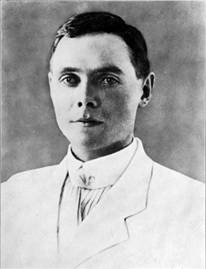 (Photo origin: Wikipedia.com; available at http://en.wikipedia.org/wiki/Paul_Popenoe)
(Photo origin: Wikipedia.com; available at http://en.wikipedia.org/wiki/Paul_Popenoe)
Paul Popenoe was raised in
California and studied Biology. As a journalist, he wrote columns promoting
eugenics. He believed that charity was the reason society had so many
degenerates that had survived for so long. He conducted extensive research
about IQs and the individuals who had been sterilized in order to promote
the cause (Stern, Eugenic Nation, pp. 105-107). Working with E.S.
Gosney, he researched California’s eugenic institutions and helped promote the
program (Braslow, p. 41). Although he continued to work on Eugenics for the
rest of his life, he eventually had to denounce negative eugenics as it fell
out of favor in the 1940s (Stern, Eugenic Nation, p. 106).
 (Phote origin: Wikipedia.com; available at http://en.wikipedia.org/wiki/
(Phote origin: Wikipedia.com; available at http://en.wikipedia.org/wiki/
E.S. Gosney was a
philanthropist who helped to finance and promote the eugenics program
(Popenoe). He worked along with Popenoe to collect data about sterilizations by
researching California’s state institutions. He helped fund and create
the Human Betterment Foundation for well-known wealthy individuals who
supported eugenics. The HBF funded surveys to study the effects of
sterilizations and promote its benefits (Bruinius, p. 272). Unlike many
eugenic supporters of the day, his focus was primarily on the benefits for
society, not the benefits for the individual (Braslow, p. 41).
F.O.
Butler was the superintendent of Sonoma State home starting in 1918. He
believed that sterilization benefited both the individuals and society as a
whole (Butler) Both through public promotion and actual operations, he was
largely responsible for thousands of sterilizations. He himself is estimated to
have performed at least 1000 sterilizations throughout his career (Kline, p.
52). Preventative public health measure (Kline, p. 52).
Charles
M. Goethe was a businessman from Sacramento who promoted eugenics in the San
Francisco area (Stern, “Sterilized”, p. 1129). He advocated for eugenic policy
including immigration restriction, “better breeding”, and sterilization. With a
background in plants and animals, he viewed eugenics as a way of improving the
human race (Center for Science, History, Policy, and Ethics).
Frederick W. Hatch, Jr. was
the secretary of the State Lunacy Commission in California. After the
sterilization law was passed in 1909, he became the General Superintendent of
State Hospitals. He held this position for the rest of his life, using it to
implement policy and hire hospital administrators in favor of eugenics. While
he held this position, about 3,000 people were sterilized in California
(Gottshall). Even after his death in 1924, his legacy of an active
program for sterilization lived on through the next hospital superintendents.
Ulysses S. Webb was the
attorney general of California during much of the Progressive Era, holding that
position for 37 years. He was confident that eugenic sterilization laws,
especially those requiring some form of consent, would survive a challenge by
the courts. He preferred that sterilizations be used as a medical treatment,
rather than as a punishment by the courts (Gottshall).
Public Support
The Race Betterment Exhibit 1915 in San Francisco
promoted “positive eugenics” as a way to counter race degeneracy. Also warned
against the “moron girl”, those who were abnormal as a biological threat
(Kline, p. 30). Questionable sexual behavior indicated a primitive
savagery and qualified the afflicted individual and unfit to reproduce (Kline,
p. 31).
A 1935-1941 Los Angeles Times “Social Eugenics” column, written by Fred Hogue,
summarized the American Eugenics Society meetings and cited publications of the
HBF to promote the social and economic benefits of sterilization (Currell and
Cogdell, p. 38). Sacrifice of individual for public good. 66% approved
compulsory sterilization according to 1937 Fortune Magazine survey (Currell and
Cogdell, p. 37).
Eugenics was integrated into the curriculum of California’s public
schools. Biology, sociology, and home management textbooks all contained
the “evidence” supporting the cause. This, in addition to the propaganda
from eugenics societies resulted in overall public support for the movement in
California (La Chappelle, p. 34).
“Feeder Institutions” and institutions where sterilizations were performed
 (Photo origin: Alex Wellerstein; available at http://www.people.fas.harvard.edu/~wellerst/collection/)
(Photo origin: Alex Wellerstein; available at http://www.people.fas.harvard.edu/~wellerst/collection/)
The Sonoma
State Home was a
state hospital founded in 1884 and was initially designed to help
educate
mentally disabled children (Kline, p. 30). However, Sonoma would
eventually become the institution that set the stage for sterilization,
providing an example for institutions all over the world (Kline,
p.
30). This transition came with the emergence of eugenics.
Since
abnormal traits that were thought to be inherited, sterilization was
seen as a
way to prevent the degeneration of the race through the procreation of
those
with undesirable traits (Kline, p. 30). Rather than protecting
patients
from society, institutions were instead used to protect society from
the very
same patients. It was especially focused on sterilizing women who
were
considered sexually deviant (Kline, p. 32). Many of these
women were
considered such because they had sex outside of marriage. Such an act
was
considered an implication the mental deficiency of the individual and
qualified
them for institutionalization and sterilization (Kline, p. 30). Under
the
direction of Butler, Sonoma acted as a kind of “revolving operating
room” in an
attempt to expand beyond the institution, Sonoma admitted patients
solely for
the purpose to be sterilized and then released. According to a study
conducted
by Paul Popenoe, between the years 1922-1925, 25% of those females
sterilized
fell into this category (Kline, p. 53). This aggressive approach
is
likely the reason for Sonoma’s comparatively high number of
sterilizations. Sonoma was said to have sterilized more “mental
defectives” than any other institution in
the world up to 1942 (Kline, p. 33). Often overlooked, Sonoma
conducted dangerous
tests and trials on patients into the 1960s. Testing in mental
institution alleviated the compensation and consent required for
researches. Such treatments, including radiation dosing
experiments,
resulted in countless injuries and deaths that are still being
investigated (60
Minutes). Still open today, renamed the Sonoma Development
Center, there
is no mention of the past on the website (State of California).
 (Source: http://www.cdcan.info/node/212)
(Source: http://www.cdcan.info/node/212)
The Pacific Colony
in Pomona was an institution that was created under the 1917
sterilization law and it dealt with the sterilization of epileptics and
mentally delayed individuals. This was created as a result of the
apparent growing number of “feeble-minded” individuals. On March
20,
1921, the first patients were admitted to Pacific Colony with an
expected
capacity of 50 patients. However, due to a lack of water and limited
access to
the colony, it soon became inappropriate for their needs and the
facility
closed on January 23, 1923. Pacific Colony reopened and would act as
the only
feebleminded institution in California, apart from Sonoma, sterilizing
patients. However, after the Garcia v State Department of Institutions
trial,
the judge contributed to the change in the current law. The new
provision
allowed patients the opportunity to fight sterilizations. This
dramatically
decreased the rate of sterilizations in all institutions in California.
In
1952, 225 sterilizations were conducted. This number dropped
dramatically after
the passing of the new law to just 51 in 1952 (Stern, "From Legislation
to
Lived Experience", p. 96). Later renamed to "Pacific State Hospital,"
its most recent name is "Frank D. Lanterman State Hospital and
Developmental Center" (see "History of Lanterman").
By 1921, in addition to the Sonoma State home and the Pacific Colony, several state mental hospitals
performed sterilizations of some kind. On average, mental hospitals averaged
five times as many inmates as the feebleminded homes in California. In 1940,
California mental hospitals held 22,953 patients as compared to 4,076 patients
in Sonoma and the Pacific Colony combined (Stern, "From Legislation to
Lived Experience", p. 100).
This resulted in their performing more total sterilizations (12,000) than
did the feebleminded homes (8,000) ( Stern, “From Legislation to Lived
Experience”, p. 100). These hospitals included Patton, Agnews, Norwalk,
Stockton, Camarillo, Mendocino, and Napa. Many of these were overcrowded.
Between 1910 to 1955, the total population of residents increased fivefold
(6,864-36,403). This was used as reasoning to sterilize more patients to
increase eugenic efficiency (Stern, "From Legislation to Lived
Experience", p. 104).
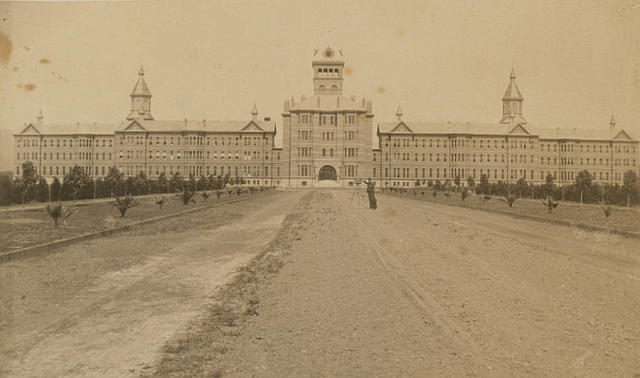 (Source: http://www.asylumprojects.org/index.php?title=File:Agnews5.png)
(Source: http://www.asylumprojects.org/index.php?title=File:Agnews5.png)
Also known as, the “Great
Asylum for the Insane,” Agnews
opened in 1885 in Santa, Clara California.
It was the third institution opened for treatment of the mentally
ill.
The 1906 earthquake severely damaged the facility and more than 100
patients
died (Santa Clara County). It reopened after the earthquake in 1911 as
Agnews State Mental Hospital. The facility was a “small, self-contained
town. “ It included shops, livestock and crops for food, as well as a
fire department. Individuals who possessed developmental
disabilities were still admitted and treated until the facility closed
in 1998, while those who are mentally ill were not longer admitted by
the year 1972. Currently, the land has been repurposed to be the
R&D campus of Sun Microsystems. In 1997, the Agnews site was
added to the National Register of Historic Places (Agnews Development
Center).
 (Source: http://livingnewdeal.berkeley.edu/map/view.php?l=243)
(Source: http://livingnewdeal.berkeley.edu/map/view.php?l=243)
Camarillo State Hospital, located in Ventura County California, had just 406 patients when it opened in 1936. The population grew to 1,082 in 1937; 2,501 in 1940, 4,123 in 1945, 4,960 in 1950, 6,748 on April 8, 1953, 6,865 on June 30, 1955, and in excess of 7,000 patients in 1957. This growth was similar to the trends seen in other state institutions. During the 1950s-1960s Camarillo was thought to be at the forefront of schizophrenia treatments. Camarillo was likely a place of numerous acts of patient abuses and negligent deaths despite claims of ground-breaking cures for insanity. Electroshock therapy ended at Camarillo in the 1970s. Further, it was criticized for releasing patients who likely needed more supervision. It closed as a hospital in 1997 because of low patient numbers and rising costs per patient (California State Mental Hospital). The land is now used for a California State University (Camarillo State Mental Hospital).
 (Source: http://www.people.fas.harvard.edu/~wellerst/collection/images/mendocino_state_hospital3.jpg)
(Source: http://www.people.fas.harvard.edu/~wellerst/collection/images/mendocino_state_hospital3.jpg)Mendocino State Hospital, located in Ukiah, California, opened in the 1890s and closed in the 1970s. It was located in an isolated part of Northern California so as to keep the activities somewhat covert. However, as compared to institutions such as Sonoma, Mendocino sterilized comparatively few people (Wellerstein).
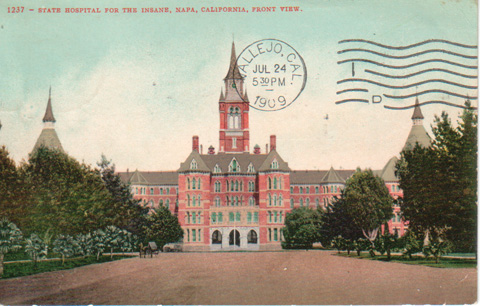 (Source: http://www.people.fas.harvard.edu/~wellerst/collection/image.cgi?hospital_napa)
(Source: http://www.people.fas.harvard.edu/~wellerst/collection/image.cgi?hospital_napa)
Napa State
Hospital was opened on November 15, 1875. Again, similar self
sustaining farm and self sustaining facilities were incorporated onto
the site so that that hospital could keep patient costs low. The
facility is still in use, and little can be found about the its likely
controversial history. Currently, the facility’s website states
that its mission is to "provide hope to adults with serious mental
illness and support each individual to achieve personal recovery" (Napa
State Hospital).
 (Source: http://www.asylumprojects.org/index.php?title=File:Norwalk.jpg)
(Source: http://www.asylumprojects.org/index.php?title=File:Norwalk.jpg)
Norwalk
State Hospital was opened in 1915 through legislation signed by
California Governor H. W. Johnson (1866-1945) (California Department of
Mental
Health). Similar to Agnews, the facility was self-sufficient in its
early days, having livestock, and crops. This system was put in
place to keep costs down. It is now known as Metropolitan Sate
Hospital, and it located in Los Angeles, California. It is
currently still in use, and in July 2002 had about 825 patients.
Unlike many other current mental facilities, it admits acutely ill
psychiatric patients, resulting in short says and a high turnover rate
("Metropolitan State Hospital")
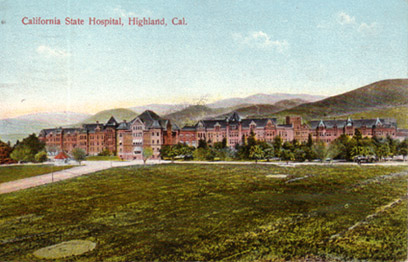 (Source: http://www.asylumprojects.org/images/7/76/Patton.jpg)
(Source: http://www.asylumprojects.org/images/7/76/Patton.jpg)
Patton, located in San Bernadino, was opened in 1893 and acted and the main mental hospital for Southern California. In its peak year, there were 180 sterilizations performed (98 men, and 82 women) (Stern, "From Legislation to Lived Experience", p. 104). Since the passage of the 1909 sterilization law, the superintendents at Patton were very pro sterilization for both eugenic and therapeutic purposes (Stern, "From Legislation to Lived Experience", p. 105). According to Superintendent Dr. John A Riely, the denial of parenthood was far outweighed by the benefits on society. His successor, Dr. G.M Webster, echoed Butler’s strategy of sterilizing every patient that entered the hospital to prevent further procreation. Further, sterilizations were motivated because of the extreme overcrowding at the institution. Regularly reporting an excess of 50%, Patton grew at an even greater rate as compared to the average for state mental hospitals (Stern, "From Legislation to Lived Experience", p. 105).
 (Photo origin: Alex Wellerstein; available at http://www.people.fas.harvard.edu/~wellerst/collection/)
(Photo origin: Alex Wellerstein; available at http://www.people.fas.harvard.edu/~wellerst/collection/)
While Stockton State Hospital had a higher population than Patton, sterilization rates were lower because there was not as much overcrowding (Stern, "From Legislation to Lived Experience", p. 107). The California State Hospital at Stockton performed the largest amount of sterilizations out of the six state hospitals. Prior to June 1926, physicians at Stockton had performed over ten times as many sterilizations as at Agnews State Hospital, accounting for almost 40% of the total amount performed up to this date (Barslow, p. 36). The large-scale sterilization at Stockton was made possible because the physicians at Stockton believed in the medical value of sterilization and demonstrated this conviction in their work. Even though these doctors did have hereditarian beliefs, these were not the ones that guided their decision to operate. They genuinely believed that patients that had undergone sterilization showed “marked improvement” (Barslow, p. 38). Rather than seeing sterilization as a way to prevent the degeneration of the human stock, these physicians saw the surgery as an intervention aimed at improving the individual’s life. The belief in therapeutic benefits allowed for male sterilization prior to the 1930s to escalate. Doctors believed that the patients felt mentally and physically stronger after the surgery. Although this belief waned by the mid-1930s, it made it possible for more sterilizations to occur. In addition, patients shared the belief that sterilization was therapeutic, making it easier to perform the operation (Barslow, p. 44). This belief was also demonstrated in the sterilization of women. Sterilization of women was guided by the belief that they were protected from psychological and social strains of childbirth and motherhood (Barslow, p. 46). This is what made Stockton unique. At Stockton, sterilization functioned as an alleged solution to a patient’s individual problems on a large scale (Barslow, p. 51). The Stockton State Hospital closed in 1996 and its ground is now part of the Stockton campus of California State University, Stanislaus.
Not all superintendents
were as aggressive in their approach of eugenics as was the case for Sonoma. Dr. Leonard Stocking of
Agnews mental hospital exemplified this in his conservative approach. Between
1903-1931, Stocking reported very few sterilizations. This cautious
approach resulted from his belief that sterilization did not directly benefit
the patient and therefore should not be practiced ( Stern, "From
Legislation to Lived Experience", 108)
The provision of the sterilization law, in congruence with a changing view of
the ethical treatment of the mental ill, resulted in the phasing out of mass
sterilizations. The National Institute of Mental Health, and the
Foundation of National Association of Retarded Children was founded helped to
change these interventions (Stern, "From Legislation to Lived
Experience", p. 110).
Finally, state prisons in California also participated in the sterilization of individuals, although on a much smaller scale. San Quinton and Folsom Prisons conducted some sterilization on inmates who were convicted of crimes of a sexual nature (Gottshall). The Folsom State Prison and the Preston School of Industry in Waterman began performing sterilizations as of January 1, 1921 (Laughlin, p. 52).
Opposition
Proponents of sterilizations
met very little opposition to their ideas. They marketed it as good for society
and the individuals sterilized. Towards the later part of the eugenics
movement, activist groups began protesting the injustices committed against
their members. These included both African Americans and Mexicans in the 1950s
and 1960s (Stern, “Sterilized,” p. 1134). There were also two court cases that
challenged the sterilization law. The first of these was the Hewitt case in
which a young woman was sterilized against her will but with the consent of her
mother. However the case was not brought to trial (Paul, p. 262). The second
case, known as the Garcia case, involved a petition to end the enforcement of
the sterilization law. This case was also not heard because it supposedly
lacked any facts justifying a hearing (Paul, pp. 265-266).
Commemoration
March
2003, Governor Gray Davis apologized in Sacramento to all those affected by the
eugenics movement in California. However, very few people have come
forward publically to be at the receiving end of this apology (Stern, Eugenic
Nation, p. 211). Consequently, there is a lack of dialogue
between the state and those sterilized. Without commemoration sponsored
by the government, the eugenics movement has the potential to a forgotten part
of history.
In the fall of 2005, California’s first ever exhibition of the state’s eugenic
history was run for four weeks at the Library Gallery at California State
University Sacramento. The exhibit was called “Human Plants, Human
Harvest: The Hidden History of California Eugenics.” The public is unaware of
this history and there was no common background or knowledge on the subject
upon which to build an exhibition. Therefore, the exhibit took the visitors
through a series of seven sections of visual chapters of flat wall-pieces that
were mounted in between two huge sheets of Plexiglas. The exhibit utilized
high-quality reproductions of historical photographs and documents (Brave and
Sylva, p. 38). These images, although they spark interest, had to be used
carefully because they range from “ludicrous to loathsome” and therefore had
the potential to be viewed as illegitimate pieces of information (Brave and
Sylva, p. 39). Since the images served as the major carriers of
information to the visitors, it was necessary to secure the visitors’ trust
that this history did actually happen.
This exhibit was created for several reasons. One is that the eugenics
movement has been underrepresented in visual media, while there has been many
books published and read on the issue. As a visual culture, a visual
representation is necessary in order to reach the public. It was also created
because people were concerned that California’s history of eugenics would
remain unknown. However, some resisted the uncovering of this information
because they saw the exhibit as being perceived as more “feel-bad” than “feel-good”
(Brave and Sylva, p. 42). Overall, however, many visitors viewed the exhibit as
both eye-opening and shocking, as “powerful and beautiful in its truth telling”
(Brave and Sylva, p. 43). There is no memorial for the 20,108 people sterilized
in California, and other than a governor’s apologies for the past, this is the
first public commemoration of California’s eugenic past.
Bibliography
Agnews Developmental Center." Wikipedia.org. Available at <http://en.wikipedia.org/wiki/Agnews_Developmental_Center>
"Agnews Insane Asylum." 2011. Santa Clara
County. 15 Apr. 2011. Available at <http://www.nps.gov/nr/travel/santaclara/agn.htm>.
Braslow, Joel T. 1996. "In
the Name of Therapeutics: The Practice of Sterilization in a California State
Hospital." Journal of the History of Medicine & Allied Sciences
51, 1: 29–51.
Brave, Ralph, and Kathryn Sylva. 2007. “Exhibiting Eugenics: Response and
Resistance to a Hidden History.” The Public Historian 29, 3: 33–51.
Bruinius, Harry. 2006. Better for All the World. New York: Alfred
A. Knopf.
Butler, F.O. 1945. “A Quarter of a Century's Experience in Sterilization of
Mental Defectives in California.” American Journal of Mental Deficiency
49, 4. Available at
<http://www.eugenicsarchive.org/eugenics/image_header.pl?id=1384&printable=1&detailed=0>
“California State Mental Hospital.” Available at <http://users.resist.ca/~kirstena/pagecamarillo.html>.
"Camarillo State Mental Hospital." Wikipedia.org. Available at <http://en.wikipedia.org/wiki/Camarillo_State_Mental_Hospital>
Center for Science, History, Policy, and Ethics. 2005. "Eugenics in
California." California State University. Available at <http://www.csus.edu/cshpe/eugenics/>.
Clayton, Stephanie E. 2003. Propagation of the Fittest: The Endurance
and Influence of The Human Betterment Foundation. Master’s Thesis.
Department of Sociology. Claremont Graduate University, 2003.
Currell, Susan, and Christina Cogdell. 2006. Popular Eugenics. Athens:
Ohio University Press.
Gottshall, Jon. 1995. "The Cutting Edge: Sterilization and Eugenics in
California, 1909–1945." The Welebaethan. Available at <http://www.gottshall.com/thesis/article.htm>.
"History of Lanterman Developmental Center." State of California Developmental Services. Available at <http://www.dds.ca.gov/Lanterman/History.cfm>
Kline, Wendy. 2001. Building a Better Race:
Gender, Sexuality, and Eugenics from the Turn of the Century to the Baby Boom.
Berkeley: University of California Press.
La Chappelle, Peter. 2007. Proud to Be an Okie: Cultural Politics, Country Music,
and Migration to Southern California. Berkeley: University of California.
Laughlin, Harry H. 1922. Eugenical Sterilization in the United States. Chicago:
Municipal Court of Chicago.
“Metropolitan State Hospital.” California Department of Mental Health. Available at <http://www.dmh.ca.gov/services_and_programs/state_hospitals/metropolitan/default.asp>
"Napa
State Hospital." California Department of Mental Health. Available at <http://www.dmh.ca.gov/services_and_programs/state_hospitals/napa/default.asp>
"Patton State Hospital." Wikipedia.org. Available at <http://en.wikipedia.org/wiki/Patton_State_Hospital>
Paul, Julius. 1965. "Three Generations of Imbeciles Are Enough: State
Eugenic Sterilization Laws in American Thought and Practice.” Unpublished
manuscript. Washington, D.C.: Walter Reed Army Institute of Research.
Popenoe, Paul. 1928. "Eugenic Sterilization in California". Canadian
Medical Association Journal. April. 18(4): 467–468. Available at <http://www.pubmedcentral.nih.gov/articlerender.fcgi?artid=1709598>.
State of California. Department of Developmental Services. “Sonoma
Developmental Center.” Available at <http://www.dds.ca.gov/Sonoma/Index.cfm>
Stern, Alexandra Minna. 2005a. Eugenic Nation: Faults and Frontiers of
Better Breeding in Modern America. Berkeley: University of California
Press.
Stern, Alexandra Minna. 2005b. “Sterilized in the Name of Public Health: Race,
Immigration, and Reproductive Control in Modern California.” American
Journal of Public Health 95, 7: 1128–38. Available at <http://www.pubmedcentral.nih.gov/articlerender.fcgi?artid=1449330>
Stern, Alexandra Minna. 2011. "From Legislation to Lived Experience: Eugenic
Sterilization in California and Indiana, 1907-79." Pp. 95-116 in A
Century of Eugenics in America, ed. Paul A. Lombardo. Bloomington: Indiana University Press.
"Stockton State Hospital." Wikipedia.org. <http://en.wikipedia.org/wiki/Stockton_State_Hospital>